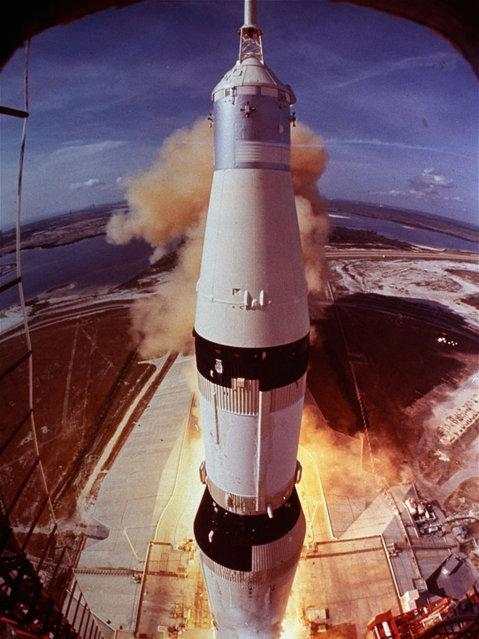
In this July 16, 1969 file photo provided by NASA, the Saturn V rocket that launched Neil Armstrong, Buzz Aldrin and Michael Collins on their Apollo 11 moon mission lifts off at Cape Kennedy, Fla. For the 45th anniversary of the Apollo 11 mission, Aldrin asked everyone to remember where they were when he and Armstrong became the first humans to step onto another heavenly body, and to share their memories online. (Photo by AP Photo/NASA)
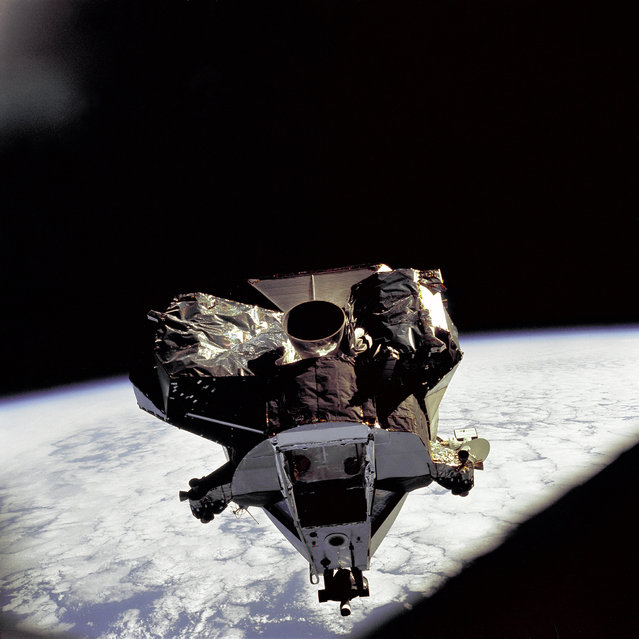
The Lunar Module “Spider” ascent stage is photographed from the Command/Service Module on the fifth day of the Apollo 9 earth-orbital mission. The Lunar Module's descent stage had already been jettisoned. (Photo by NASA)
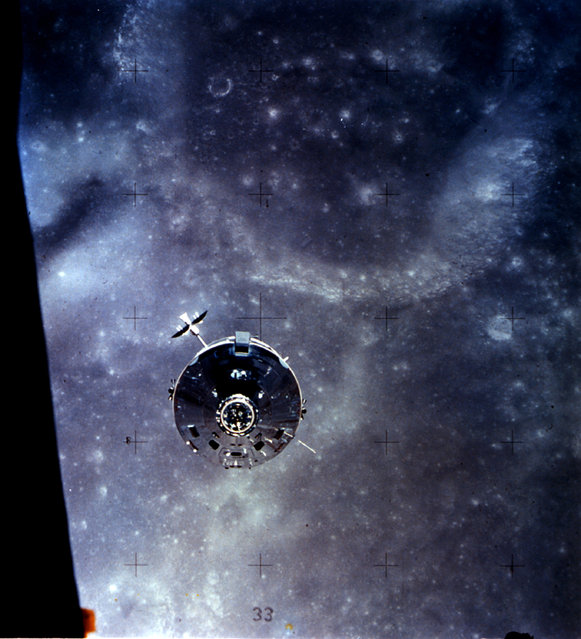
In this photo, the Apollo 16 Command and Service Module (CSM) “Casper” approaches the Lunar Module (LM). The two spacecraft were about to make their final rendezvous of the mission, on April 23, 1972. Astronauts John W. Young and Charles M. Duke Jr., aboard the LM, were returning to the CSM in lunar orbit after three successful days on the lunar surface. Astronaut Thomas K. Mattingly II was in the CSM. (Photo by NASA)
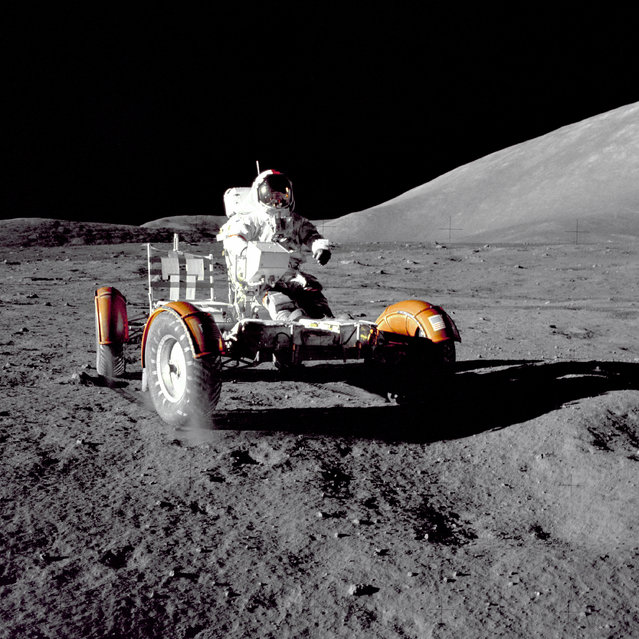
Astronaut Eugene A. Cernan, Apollo 17 mission commander, makes a short checkout of the Lunar Roving Vehicle during the early part of the first Apollo 17 extravehicular activity (EVA-1) at the Taurus-Littrow landing site. This view of the “stripped down” Rover is prior to loadup. This photograph was taken by Geologist-Astronaut Harrison H. Schmitt, Lunar Module pilot. The mountain in the right background is the East end of South Massif. (Photo by NASA)
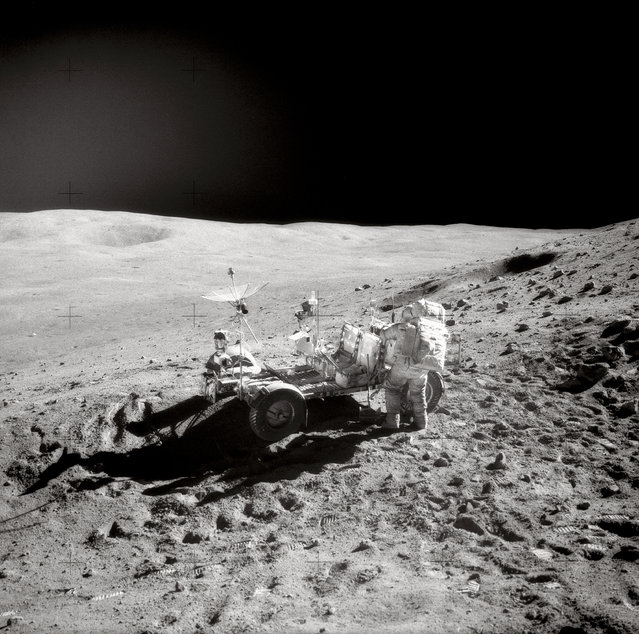
Astronaut John W. Young, Commander of the Apollo 16 mission, replaces tools in the hand tool carrier at the aft end of the “Rover” Lunar Roving Vehicle (LRV) during the second Apollo 16 extravehicular activity (EVA-2) at the Descartes landing site. This photograph was taken by Astronaut Charles M. Duke Jr., Lunar Module pilot. Smokey Mountain, with the large Ravine crater on its flank, is in the left background. This view is looking Northeast. (Photo by NASA)
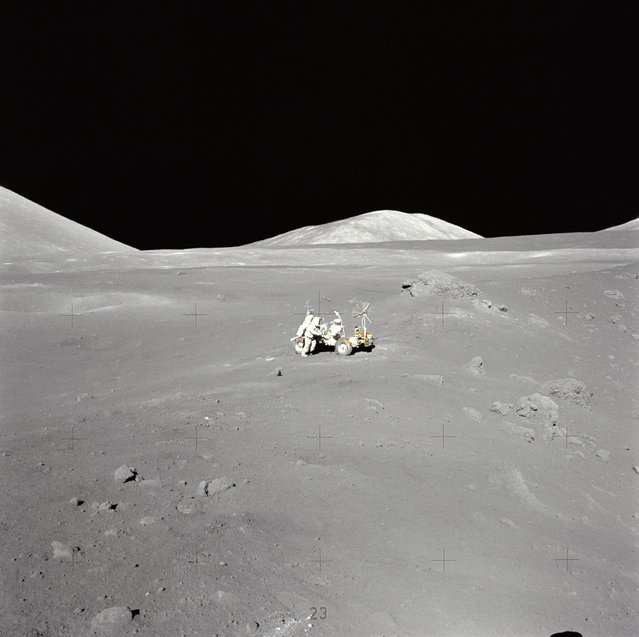
An extraordinary lunar panorama at Station 4 (Shorty Crater) showing Geologist-Astronaut Harrison H. Schmitt working at the Lunar Roving Vehicle (LRV) during the second Apollo 17 extravehicular activity (EVA-2) at the Taurus-Littrow landing site. This is the area where Schmitt first spotted the orange soil. Shorty Crater is to the right. The peak in the center background is Family Mountain. A portion of South Massif is on the horizon at the left edge. (Photo by NASA)
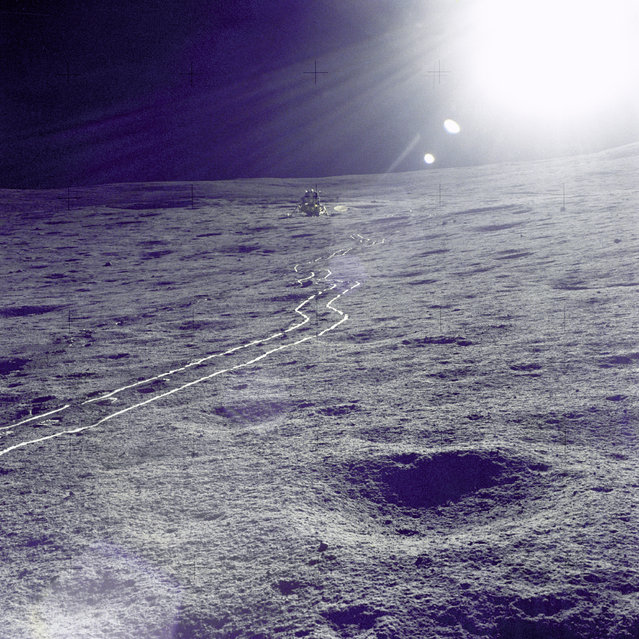
The Apollo 14 Lunar Module (LM) “Antares” is photographed against a brilliant sun glare during the first extravehicular activity (EVA-1). A bright trail left in the lunar soil by the two-wheeled Modularized Equipment Transporter (MET) leads from the LM. (Photo by NASA)
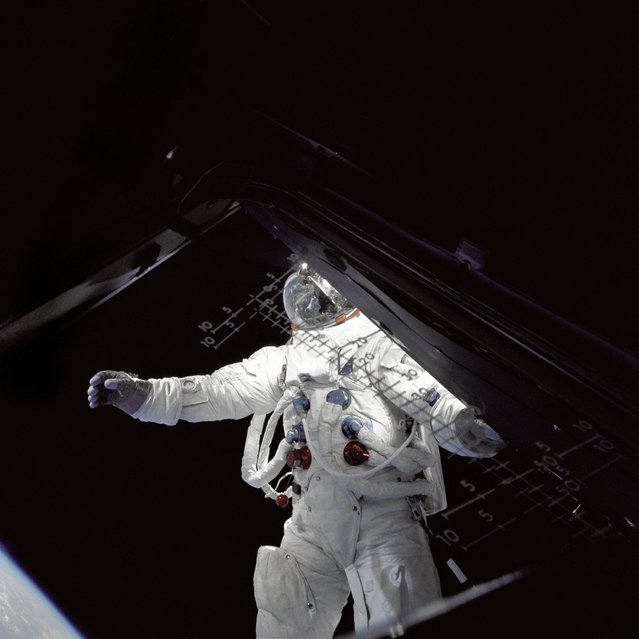
Astronaut Russell L. Schweickart, Lunar Module pilot, stands in “golden slippers” on the Lunar Module “Spider's” porch during his extravehicular activity on the fourth day of the Apollo 9 earth-orbital mission. This photograph was taken from inside the Lunar Module “Spider”. The Command/Service Module and Lunar Module were docked. Schweickart is wearing an Extravehicular Mobility Unit (EMU). (Photo by NASA)
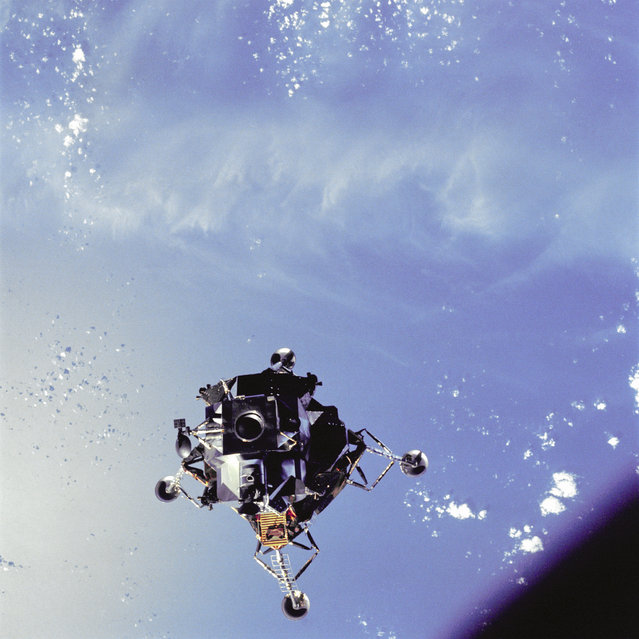
View of the Apollo 9 Lunar Module “Spider”, in a lunar landing configuration, as photographed form the Command/Service Module on the fifth day of the Apollo 9 earth-orbital mission. The landing gear on the Lunar Module has been deployed. Note Lunar Module's upper hatch and docking tunnel. The EVA foot restraints known as the “Golden Slippers” are visible on the porch of the Lunar Module (LM). They allowed Lunar Module pilot Russell “Rusty” Schweickart to securely stand on the porch during his EVA thus allowing him free use of his hands. (Photo by NASA)
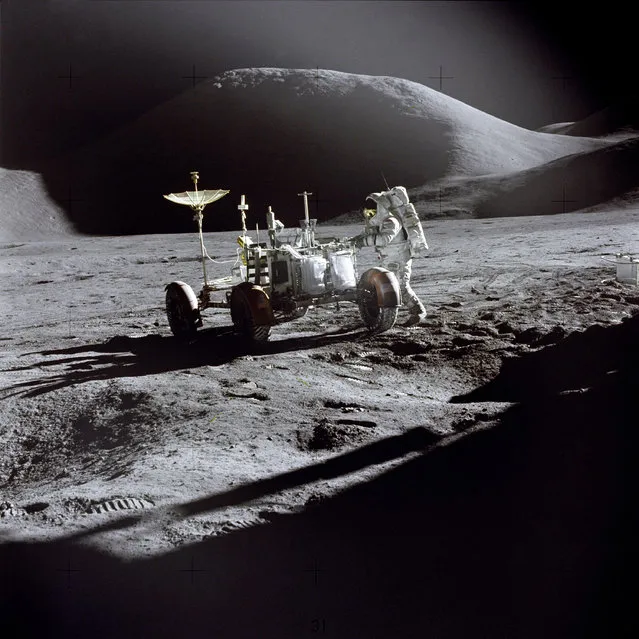
Astronaut James B. Irwin, Lunar Module pilot, works at the Lunar Roving Vehicle during the first Apollo 15 lunar surface extravehicular activity (EVA-1) at the Hadley-Apennine landing site. The shadow of the Lunar Module “Falcon” is in the foreground. This view is looking northeast, with Mount Hadley in the background. This photograph was taken by Astronaut David R. Scott, Commander. (Photo by NASA)
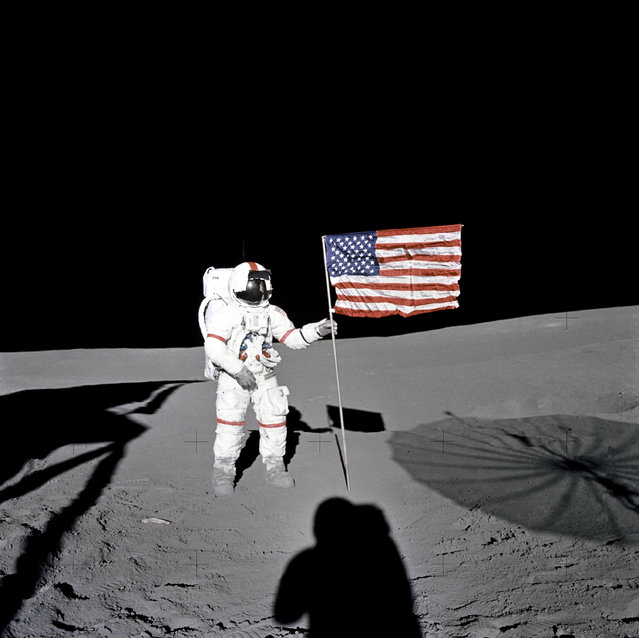
Astronaut Alan B. Shepard Jr., Apollo 14 Commander, stands by the U.S. flag on the lunar Fra Mauro Highlands during the early moments of the first extravehicular activity (EVA-1) of the mission. Shadows of the Lunar Module “Antares”, astronaut Edgar D. Mitchell, Lunar Module pilot, and the erectable S-band Antenna surround the scene of the third American flag planting to be performed on the lunar surface. (Photo by NASA)
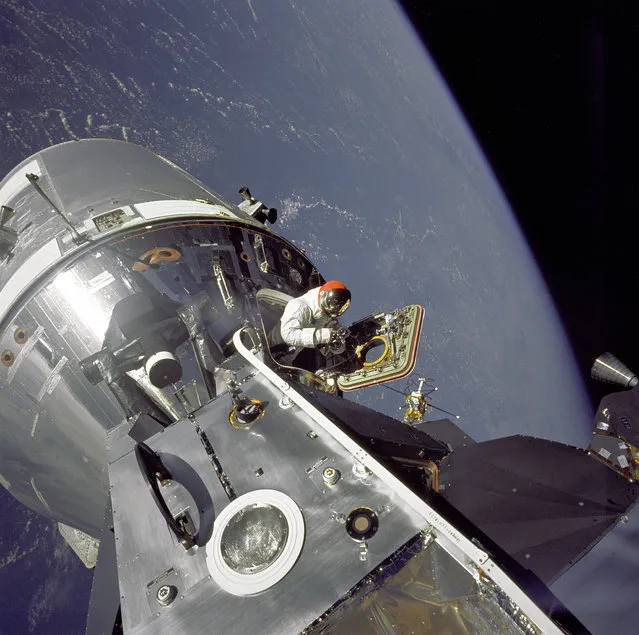
Apollo 9 Command/Service Modules (CSM) nicknamed “Gumdrop” and Lunar Module (LM), nicknamed “Spider” are shown docked together as Command Module pilot David R. Scott stands in the open hatch. Astronaut Russell L. Schweickart, Lunar Module pilot, took this photograph of Scott during his EVA as he stood on the porch outside the Lunar Module. Apollo 9 was an Earth orbital mission designed to test docking procedures between the CSM and LM as well as test fly the Lunar Module in the relative safe confines of Earth orbit. (Photo by NASA)
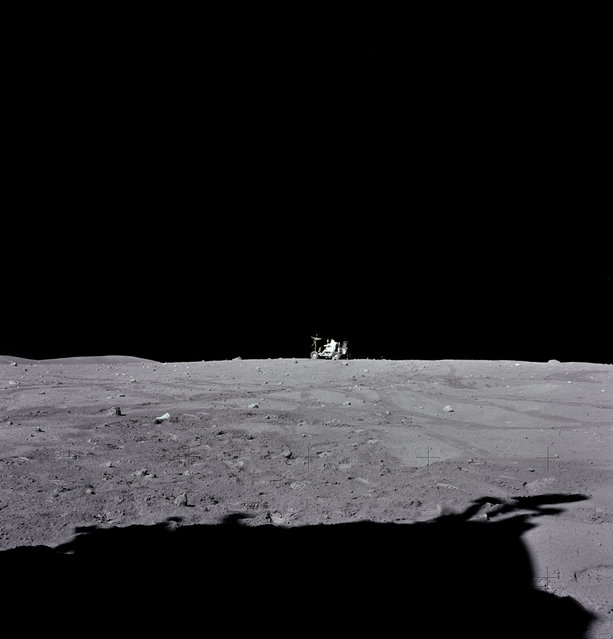
Astronaut John W. Young, Apollo 16 mission commander, drives the “Rover”, Lunar Roving Vehicle (LRV) to its final parking place near the end of the third extravehicular activity (EVA-3) at the Descartes landing site. Astronaut Charles M. Duke Jr., Lunar Module pilot, took this photograph looking southward. The flank of Stone Mountain can be seen on the horizon at left. The shadow of the Lunar Module “Orion” is visible in the foreground. (Photo by NASA)
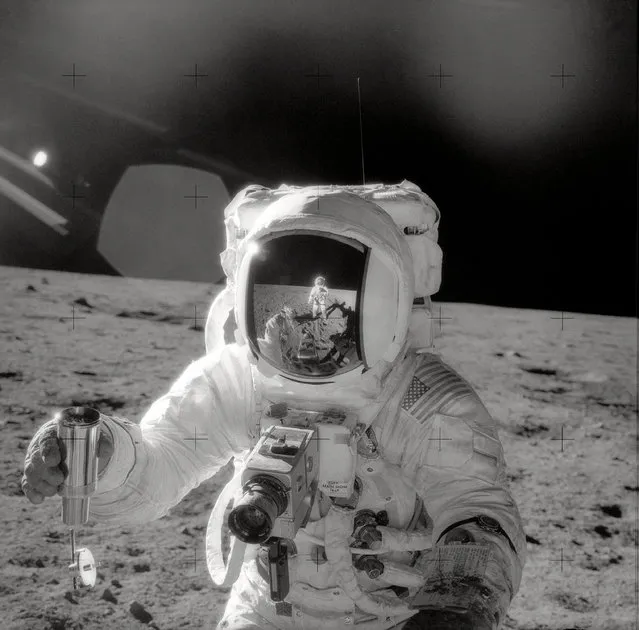
Astronaut Alan L. Bean, Lunar Module pilot for the Apollo 12 lunar landing mission, holds a Special Environmental Sample Container filled with lunar soil collected during the extravehicular activity (EVA) in which Astronauts Charles Conrad Jr., commander, and Bean participated. Connrad, who took this picture, is reflected in the helmet visor of the Lunar Module pilot. (Photo by NASA)
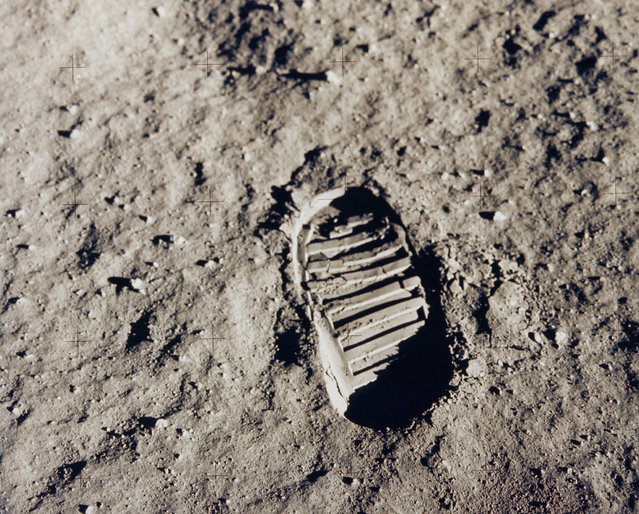
One of the first steps taken on the Moon, this is an image of Buzz Aldrin's bootprint from the Apollo 11 mission. Neil Armstrong and Buzz Aldrin walked on the Moon on July 20, 1969. (Photo by NASA)
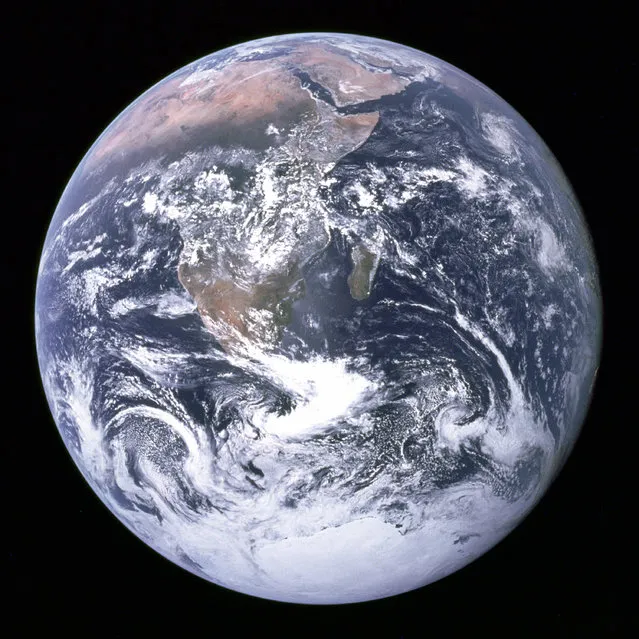
View of the Earth as seen by the Apollo 17 crew traveling toward the Moon. This translunar coast photograph extends from the Mediterranean Sea area to the Antarctica South polar ice cap. This is the first time the Apollo trajectory made it possible to photograph the South polar ice cap. Note the heavy cloud cover in the Southern Hemisphere. Almost the entire coastline of Africa is clearly visible. The Arabian Peninsula can be seen at the Northeastern edge of Africa. The large island off the coast of Africa is the Malagasy Republic. The Asian mainland is on the horizon toward the Northeast. (Photo by NASA)
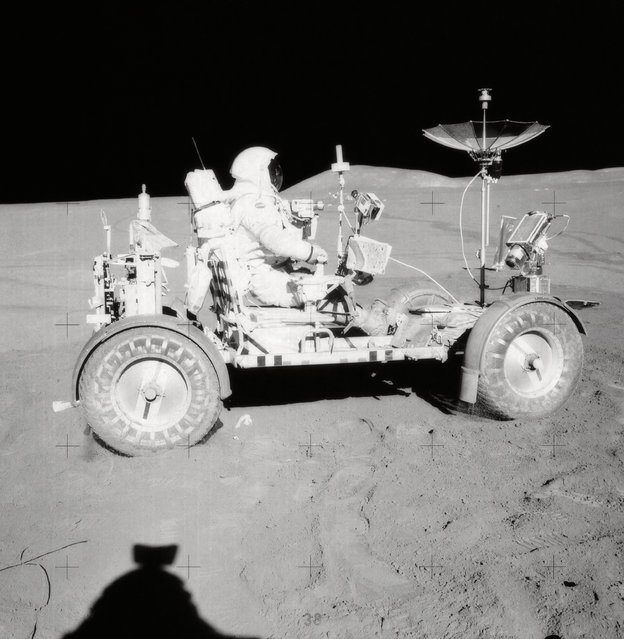
David R. Scott, Apollo 15 Commander, is seated in the Rover, Lunar Roving Vehicle (LRV) during the first lunar surface extravehicular activity (EVA-1) at the Hadley-Apennine landing site. (Photo by NASA)
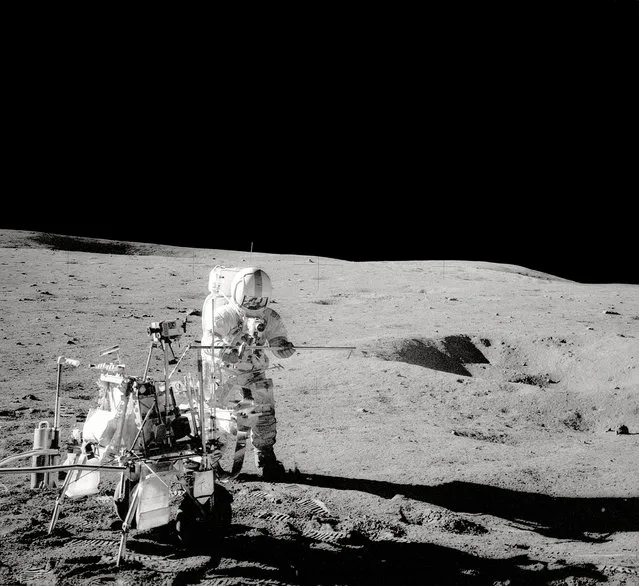
Apollo 14 Commander Alan Shepard stands by the Modular Equipment Transporter (MET). The MET, which the astronauts nicknamed the “rickshaw”, was a cart for carrying around tools, cameras and sample cases on the lunar surface. Shepard can be identified by the vertical stripe on his helmet. After Apollo 13, the commander's spacesuit had red stripes on the helmet, arms, and one leg, to help identify them in photographs. (Photo by NASA)
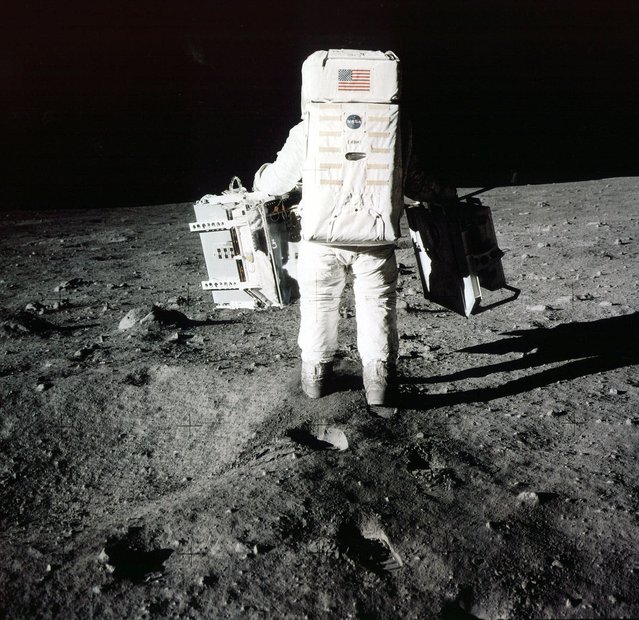
In this July 20, 1969 file photo provided by NASA, Edwin “Buzz” Aldrin carries scientific experiments to a deployment site south of the lunar module Eagle during the Apollo 11 mission. One experiment involved the inner composition of the moon, and another tried to determine the exact distance from Earth. Aldrin, 84, is asking everyone to remember where they were when he and Neil Armstrong became the first humans to walk on the moon and to share their memories online. (Photo by AP Photo/NASA)
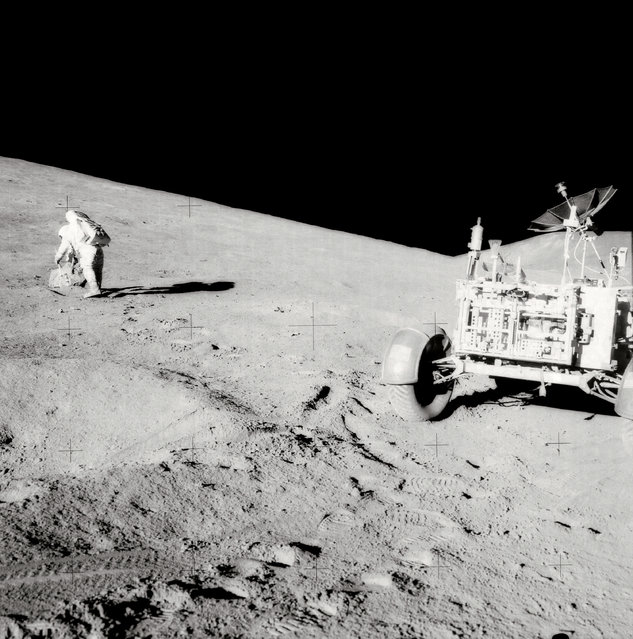
Astronaut David R. Scott, mission commander, with tongs and gnomon in hand, studies a boulder on the slope of Hadley Delta during the Apollo 15 lunar surface extravehicular activity. The Lunar Roving Vehicle (LRV) or Rover is in right foreground. View is looking slightly south of west. “Bennett Hill” is at extreme right. Astronaut James B. Irwin, lunar module pilot, took this photograph. (Photo by NASA)
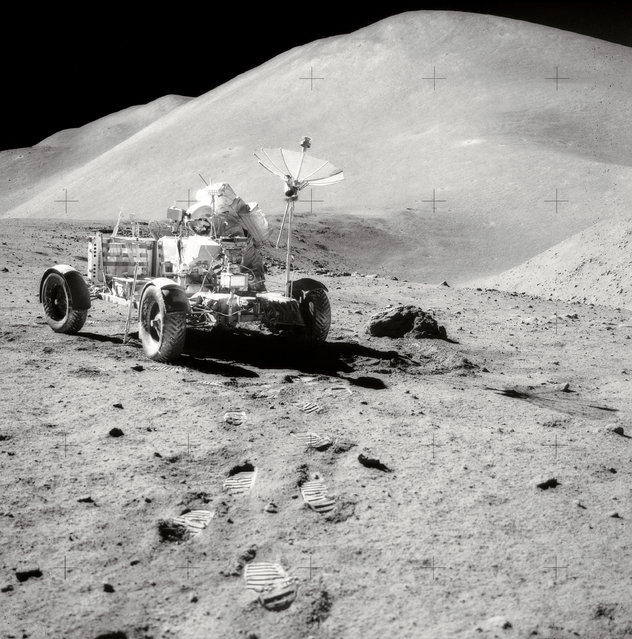
David R. Scott, Commander of Apollo 15, works at the Lunar Roving Vehicle (LRV) during the third lunar surface extravehicular activity (EVA) of the mission at the Hadley-Apennine landing site. Hadley Rille is at the right center of the picture. Hadley Delta, in the background, rises approximately 4,000 meters (about 13,124 feet) above the plain. St. George Crater is partially visible at the upper right edge. This photograph was taken by Lunar Module pilot James B. Irwin. This view is looking almost due South. (Photo by NASA)
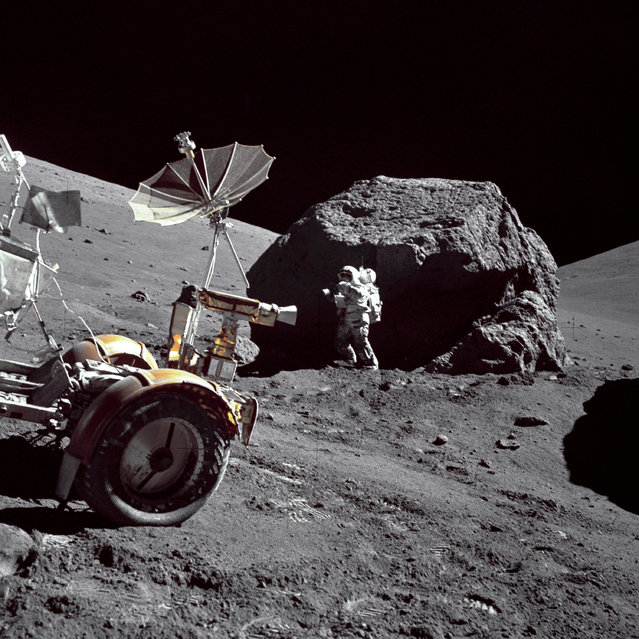
Geologist-Astronaut Harrison H. Schmitt is photographed standing next to a huge, split boulder at Station 6 on the sloping base of North Massif during the third Apollo 17 extravehicular activity (EVA-3) at the Taurus-Littrow landing site. The “Rover” Lunar Roving Vehicle (LRV) is in the left foreground. Schmitt is the Apollo 17 Lunar Module pilot. This picture was taken by Commander Eugene A. Cernan. (Photo by NASA)
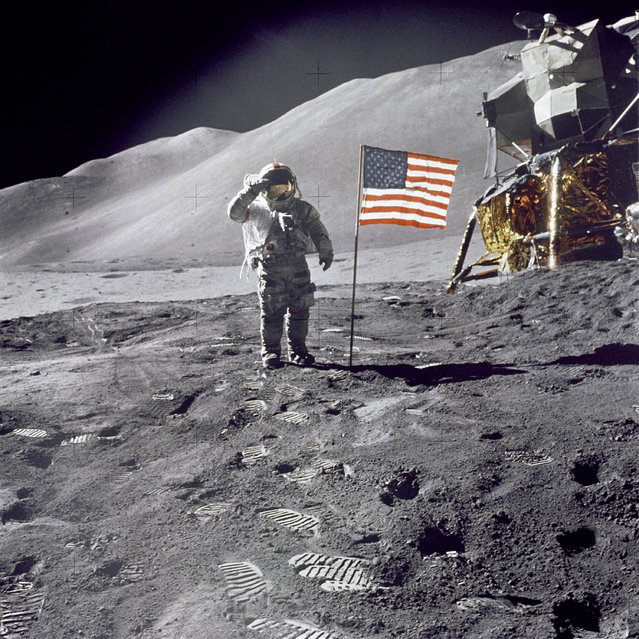
Astronaut David R. Scott, commander, gives a military salute while standing beside the deployed U.S. flag during the Apollo 15 lunar surface extravehicular activity (EVA) at the Hadley-Apennine landing site. The flag was deployed toward the end of EVA-2. The Lunar Module “Falcon” is partially visible on the right. Hadley Delta in the background rises approximately 4,000 meters (about 13,124 feet) above the plain. The base of the mountain is approximately 5 kilometers (about 3 statute miles) away. This photograph was taken by Astronaut James B. Irwin, Lunar Module pilot. (Photo by NASA)
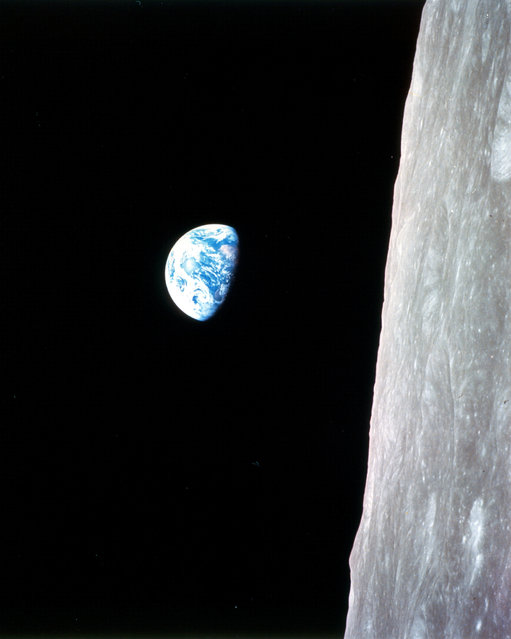
This view of the rising Earth greeted the Apollo 8 astronauts as they came from behind the Moon after the fourth nearside orbit. The photo is displayed here in its original orientation, though it is more commonly viewed with the lunar surface at the bottom of the photo. Earth is about five degrees left of the horizon in the photo. The unnamed surface features on the left are near the eastern limb of the Moon as viewed from Earth. The lunar horizon is approximately 780 kilometers from the spacecraft. Height of the photographed area at the lunar horizon is about 175 kilometers. (Photo by NASA)
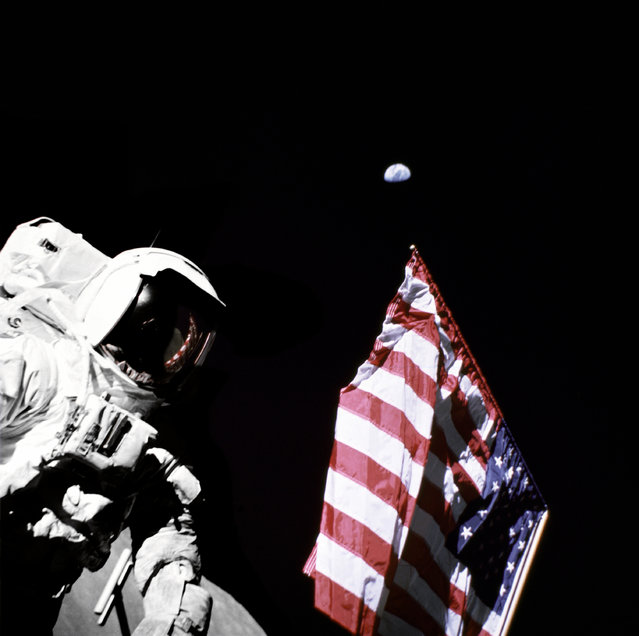
Geologist-Astronaut Harrison Schmitt, Apollo 17 Lunar Module pilot, is photographed next to the American Flag during extravehicular activity (EVA) of NASA's final lunar landing mission in the Apollo series. The photo was taken at the Taurus-Littrow landing site. The highest part of the flag appears to point toward our planet earth in the distant background. (Photo by NASA)
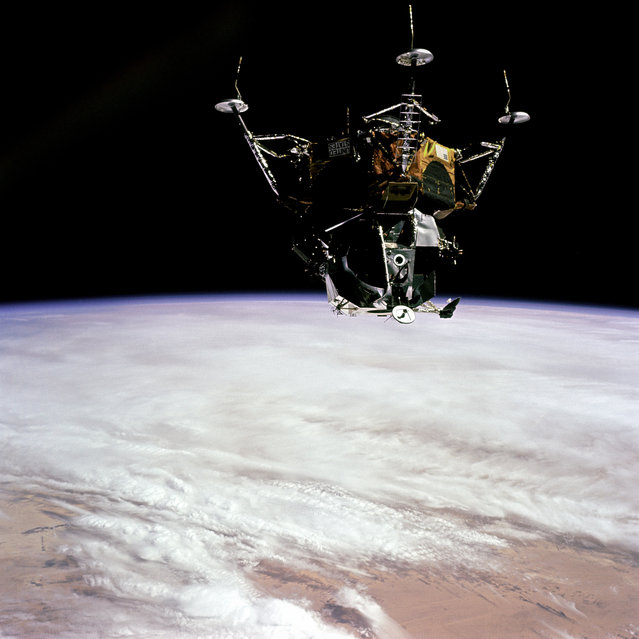
View of the Apollo 9 Lunar Module “Spider” in a lunar landing configuration photographed by Command Module pilot David Scott inside the Command/Service Module “Gumdrop” on the fifth day of the Apollo 9 earth-orbital mission. The landing gear on “Spider” has been deployed. lunar surface probes (sensors) extend out from the landing gear foot pads. Inside the "Spider" were astronauts James A. McDivitt, Apollo 9 Commander; and Russell L. Schweickart, Lunar Module pilot. (Photo by NASA)
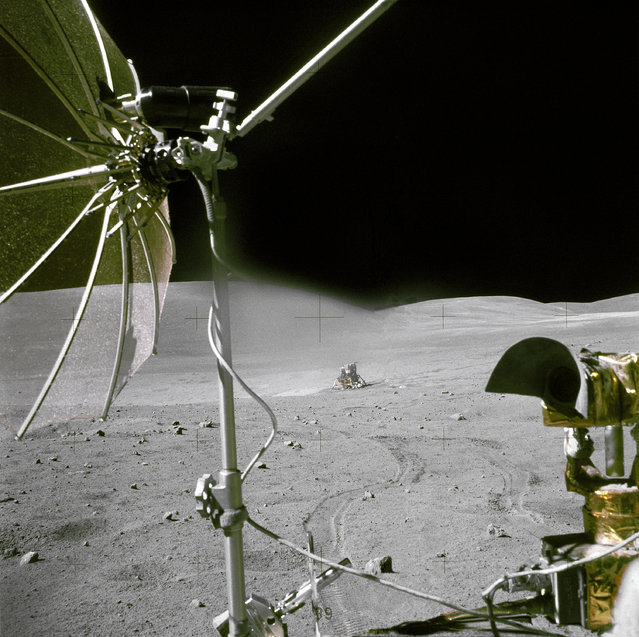
The Apollo 16 Lunar Module “Orion” is photographed from a distance by astronaut Chares M. Duke Jr., Lunar Module pilot, aboard the moving Lunar Roving Vehicle. Astronauts Duke and Commander John W. Young, were returing from the third Apollo 16 extravehicular activity (EVA-2). The RCA color television camera mounted on the LRV is in the foreground. A portion of the LRV's high-gain antenna is at top left. (Photo by NASA)
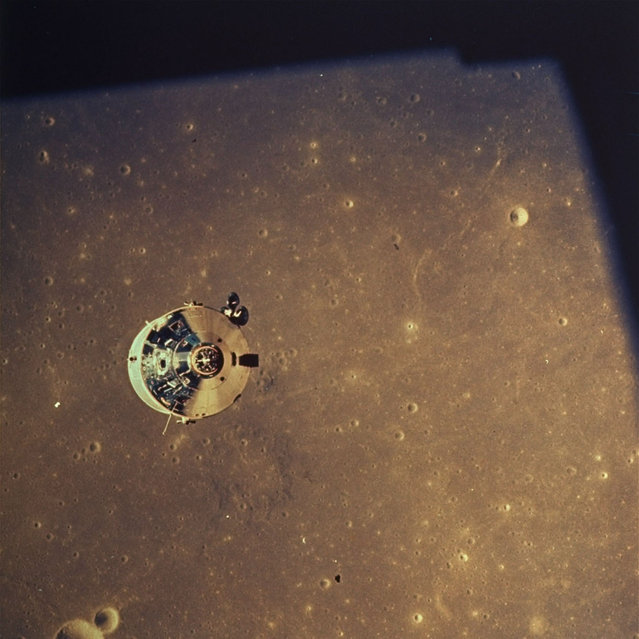
This July 20, 1969 file photo provided by NASA shows a view of the Apollo Command Module with astronaut Michael Collins aboard as seen from the Lunar Module. Astronauts Neil Armstrong and Edwin Aldrin in the Lunar Module separated from Apollo 11 to prepare to go to the lunar surface. (Photo by AP Photo/NASA)
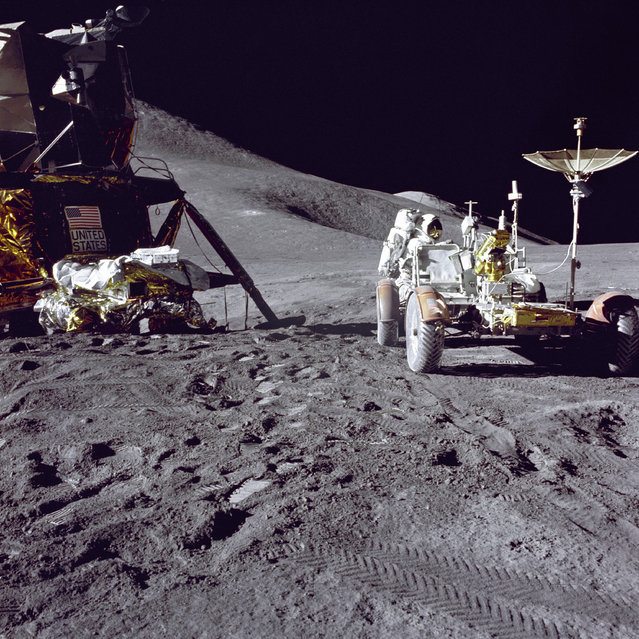
Apollo 15 Lunar Module pilot James B. Irwin loads-up the “Rover”, Lunar Roving Vehicle (LRV) with tools and equipment in preparation for the first lunar extravehicular activity (EVA-1) at the Hadley-Apennine landing site. A portion of the Lunar Module (LM) “Falcon” is on the left. The undeployed Laser Ranging Retro-Reflector (LR-3) lies atop the LM's Modular Equipment Stowage Assembly (MESA). This view is looking slightly West of South. Hadley Delta and the Apennine Front are in the background to the left. St. George crater is approximately 5 kilometers (about 3 statute miles) in the distance behind Irwin's head. (Photo by NASA)
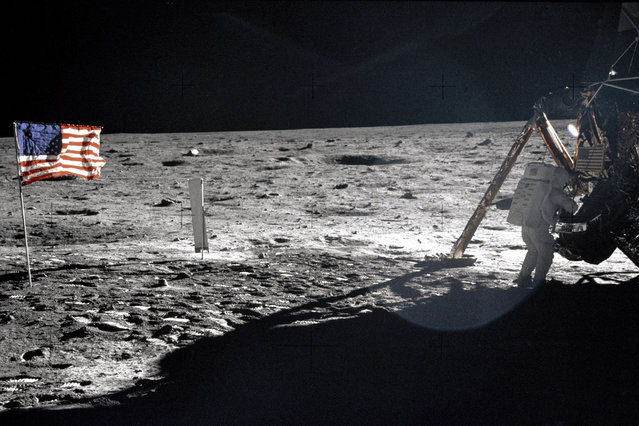
This July 20, 1969 file photo provided by NASA shows Apollo 11 astronaut Neil Armstrong on the lunar surface. Apollo 11 astronauts trained on Earth to take individual photographs in succession in order to create a series of frames that could be assembled into panoramic images. This frame from Aldrin's panorama of the Apollo 11 landing site is the only good picture of mission commander Neil Armstrong on the lunar surface. Armstrong and fellow astronaut Edwin “Buzz” Aldrin spent nearly three hours walking on the moon, collecting samples, conducting experiments and taking photographs. In all, 12 Americans walked on the moon from 1969 to 1972. (Photo by AP Photo/NASA)
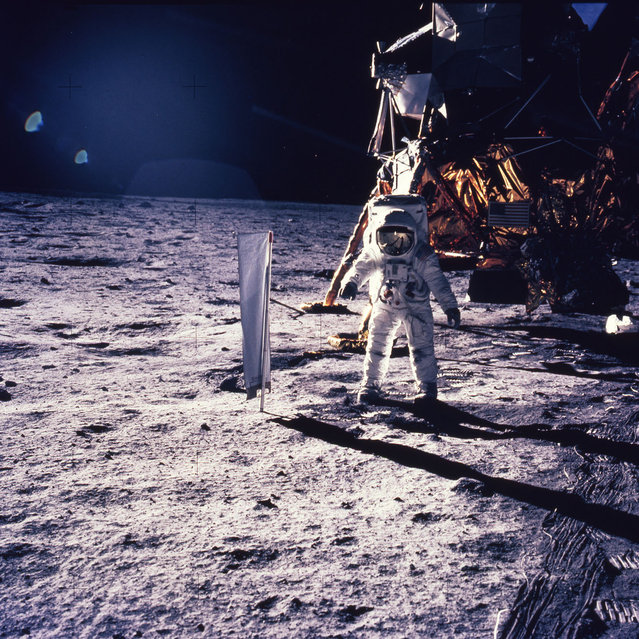
In this July 20, 1969 file photo provided by NASA, astronaut Edwin E. Aldrin Jr. walks on the surface of the moon, with seismogaphic equipment that he just set up. The flag like object on a pole is a solar wind experiment and in the background is the Lunar Landing Module. (Photo by AP Photo/NASA)
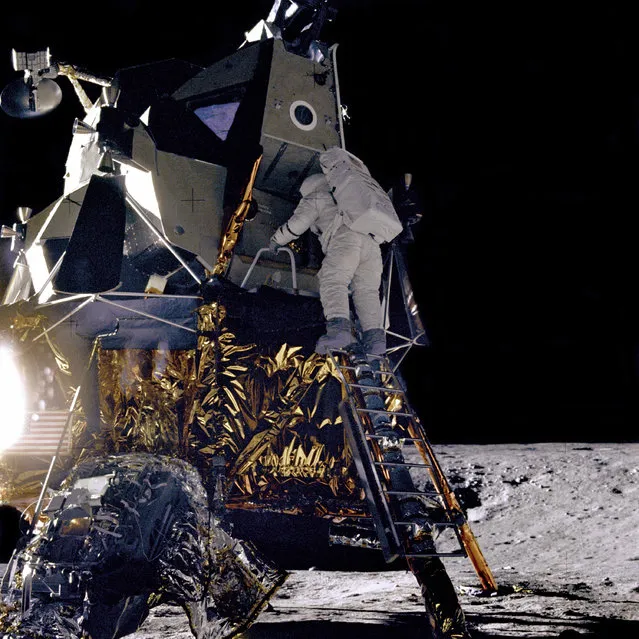
Alan L. Bean, Lunar Module pilot for the Apollo 12 mission, starts down the ladder of the Lunar Module (LM) “Intrepid” to join astronaut Charles Conrad, Jr., mission Commander, on the lunar surface. (Photo by NASA)
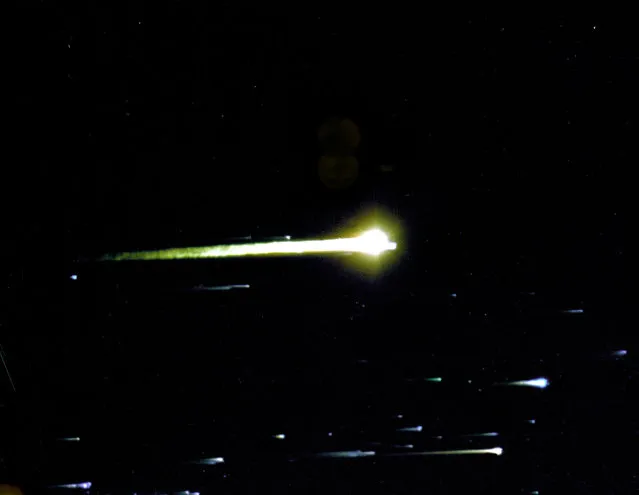
This Apollo 8 reentry photograph was taken by a U.S. Air Force ALOTS (Airborne Lightweight Optical Tracking System) camera mounted on a KC-135A aircraft flown at 40,000 ft altitude. Apollo 8 splashed down at 10:15 a.m., December 27, 1968, in the central Pacific approximately 1,000 miles South-Southwest of Hawaii. (Photo by NASA)
20 Jul 2014 11:47:00,
post received
0 comments
